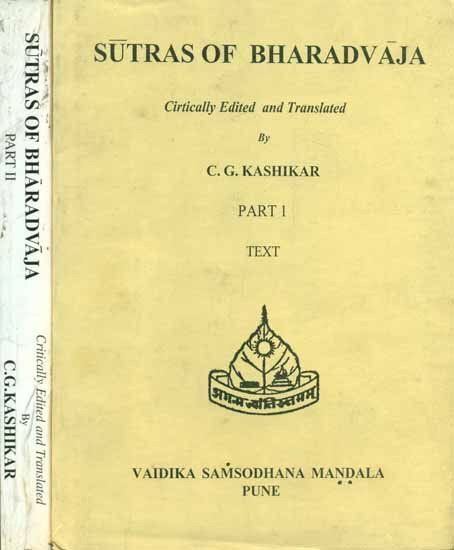Bharadvaja-srauta-sutra
by C. G. Kashikar | 1964 | 166,530 words
The English translation of the Bharadvaja-Srauta-Sutra, representing some of the oldest texts on Hindu rituals and rites of passages, dating to at least the 1st millennium BCE. The term Srautasutra refers to a class of Sanskrit Sutra literature dealing with ceremonies based on the Brahmana divisions of the Veda (Sruti). They include Vedic rituals r...
Praśna 10, Kaṇḍikā 14
1. The Adhvaryu should start the procedure of the Prāyaṇīyeṣṭi.
2. The following rites should not be performed therein: the adding of fuel to sacred fires,[1] the observance of vow,[2] the fastening of the yokehalter round the waist of the sacrificer’s wife,[3] and the anvāhārya cooked rice.[4]
3. These are not to be performed in all the Iṣṭis and Animal-sacrifices forming part of a Soma-sacrifice.
4. In the Udayanīyeṣṭi[5] and in the Anūbandhyā animal-sacrifice[6] the following two rites are (however) to be performed: the observance of vow and the fastening of the yoke-halter round the waist of the sacrificer’s wife.
5. In the Udavasānīyeṣṭi[7] all (the above-mentioned) rites except the anvāhārya cooked rice are to be performed.
6. In this connection this is the general rule: when a certain offering is introduced while a sacrifice is going on, the rites which have already been performed should not be performed again. For example, the Prayājas and the Anūyājas at the offering of the Paśupuroḍāśa and other similar rites.
7. The Adhvaryu should pour out paddy for cooked rice for Aditi.
8. The rice should be cooked in milk.
9. The procedure up to the placing of the oblation within the altar should be similar.
10. The Adhvaryu should scoop out the cooked rice, and place it within the altar with the ṣaḍḍhotṛ formula.[8]
11. In that very vessel he should place, in a marked manner, the two stirring sticks and the scrapings.
12. There should be seventeen sāmidhenī verses.
13. The procedure up to the two Ājyabhāgas[9] should be similar.
14. The Adhvaryu should offer four principal oblations of clarified butter[10] to Pathyā Svasti in the front portion of the fire, to Agni towards the south, to Soma towards the rear, and to Savitṛ towards the north.
15. He should offer the principal oblation (of cooked rice) to Aditi in the middle.
16. The Prāyaṇīyeṣṭi should be concluded with the Śaṃyuvāka.[11]
17. Some teachers prescribe the pouring out of king Soma[12] at this stage.
18. The Adhvaryu should take into the Juhū four spoonfuls out of the clarified butter taken into the Dhruvā for the Prāyaṇīyeṣṭi, tie a piece of gold to a darbha-blade with a soluble knot, and hold the piece of gold hanging with the formula, “O brilliant one, this is thy body. This is thy splendour. Be united with it. Attain brilliance.”[13]
19. The cow to be given away in exchange for Soma should not be without horns, should not be without (long) ears, should not be without eyes, should not be lame, should not have seven hoofs, and should be reddish, tawny-eyed, one year old or two years old. With a cow who is small and whose ears are hanging over her,eyes, one should purchase Soma for the sacrificer performing the Śoḍaśin [Ṣoḍaśin?] Soma-sacrifice. So is it said.[14]
Footnotes and references:
[1]:
IV.1.3.
[2]:
IV.3.9.4.
[3]:
II.5.4.
[4]:
III.3.11.
[5]:
XIV.24.1.
[6]:
XIV.24.8.
[7]:
XIV.26.1.
[8]:
Taittirīya-āraṇyaka III.1; Taittirīya-brāhmaṇa II.2.8.1.
[9]:
II.16.13.
[10]:
In view of sūtra 13 Bhāradvāja seems to have regarded the two Ājyabhāgas to be included among the principal oblations of clarified butter. However, according to the sūtra which is attributed to Bhāradvāja by Rudradatta in his commentary on Āpastamba-śrauta-sūtra X.21.11, and which has not been traced in the Bhāradvāja-texts so far, Āśmarathya holds the view that the two Ājyabhāgas are to be offered separately, while according to Ālekhana they are not.
[11]:
III.6.15.
[12]:
X.13.9.
